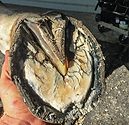Advertise Follow Us
Items Tagged with 'heart bar shoe'
ARTICLES
English farrier discusses techniques to help horses compensate for conformational issues
Read More
No Bells And Whistles, Just Keep It Simple
Kentucky farrier eases heel problems and keeps performance horses in the show ring
Read More
SHOEING FOR A LIVING
Freedom Is The Nature Of His Business
Oregon farrier molds his practice to provide quality hoof-care, while enjoying the High Desert of the Pacific Northwest
Read More
Forging a Heart Bar has Never Been Easier
Hall Of Fame farrier Myron McLane shows how to apply a frog plate to a keg shoe
Read More
Migrating Clients Require Farrier Communication And Collaboration
As seasons change and horses move between locations, farriers in different states must work together to keep horse hooves healthy
Read More
Farriers Sweat The Small Stuff To Keep Performance Horses Competing
Sore feet, abscesses occur regardless of discipline and require quick and effective hoof care
Read More
Does Grooving Benefit Quarter Cracks?
Hall Of Fame farrier Bob Pethick challenges its effects on heel displacement
Read More
Maintaining Soundness With The Navicular Horse
Recognize when it’s time to change therapeutic applications
Read More















